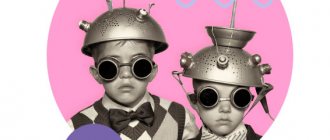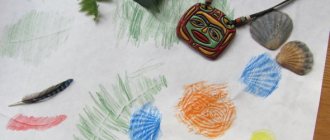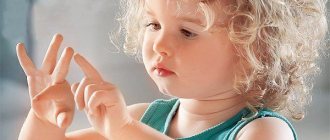Rules for drawing with a child
The main task of a parent when teaching a child to draw is to instill an interest in creativity. And if a child refuses to draw, most likely this is not due to a lack of creative abilities, but is the result of mistakes in parenting. To avoid common mistakes and develop your child’s creative potential, adhere to the following rules:
- Don't interfere. You should not impose your vision of the result on your child, or give advice and recommendations if your child does not expect them from you. Your comments may improve the quality of a particular drawing, but they will not have a long-term effect. Let your child enjoy the process and independently evaluate their work.
- Don't overdo it with auxiliary tools. Coloring books and all kinds of drawing tutorials are very popular with both children and parents. However, we must not forget that they are only good for the development of fine motor skills and patterned thinking, while a blank sheet of paper is better suited for the development of a child’s creative abilities, creativity and imagination.
- Introduce your child to aesthetics. What a child sees around him depends on what patterns for drawing will form in his head. Choose books with high-quality illustrations, well-drawn cartoons, and, if possible, introduce your child to art.
- Set an example. To teach your child to draw, lead by example. This applies not only to template images (for example, a house, the sun, a tree), but also to drawing techniques. Introduce your child to different strokes, show that paint can be splashed, mixed, etc. Then the child will develop a wonderful basis for independent drawing.
- Appreciate your child's creativity. Under no circumstances do you throw away drawings in front of your child, and don’t brush your child off if he shows you his work. Let your child know that you are proud of him! Arrange a home exhibition of drawings, and you can sign old works and put them in a folder.
Objectives of teaching drawing in different age groups
Educational:— Improve the ability to work with various visual materials, tools and artistic techniques.
— Improve the ability to obtain different shades by mixing colors.
— Strengthen the ability to work with the color wheel, determine color harmonies.
— Continue learning to harmonize colors based on diagrams and tables.
— To consolidate the ability to use the expressive capabilities of color when creating an image, reflecting not only the general properties of objects, but also one’s attitude towards it, the emotional and aesthetic state.
— Continue to learn how to subordinate various means of expression (color, shape, technique, composition) to achieve the integrity of the image.
— Continue to teach drawing techniques.
- Continue to teach how to create images of different nature (realistic, stylized, abstract) using (dots, lines, strokes, spots).
— Continue to develop compositional skills in the process of mastering patterns: texture, horizon line, balance, symmetry (asymmetry), rhythm, dynamics (statics), compositional center, perspective, chiaroscuro.
— Continue to teach drawing from life.
— Continue to introduce various types of decorative and applied arts, paintings, their motifs and elements.
— Learn to compose motifs for decorative paintings, using their elements and techniques.
- Continue to teach how to make an ornament (geometric, floral), introduce zoomorphic ornament.
- Continue to learn patterns on different shapes.
— Continue to learn how to identify simpler shapes in complex objects.
— Teach plot drawing.
Educational:
— Strengthen the ability to use a palette to obtain shades.
— Continue to develop form-building movements: drawing dots of different shapes and character; drawing straight, wavy, curved, spiral, closed and mixed lines in various combinations and compositions.
- Continue to develop a sense of color and shape; compositional skills.
— Develop: visually imaginative thinking; visual and effective thinking in the process of creating images.
— Reinforce the concepts used by the teacher at the previous age stage.
— Expand the child’s vocabulary with new special concepts: reflex, ornament, perspective: linear, aerial; depth; space; texture; structure.
- Develop memory and imagination.
Educational:
— Stimulate interest in the creative process in drawing.
— To develop aesthetic taste in the process of creating expressive images.
— Continue to cultivate accuracy when working with visual materials and tools.
— Continue to develop the ability to negotiate while creating teamwork.
— Cultivate the ability to rejoice in the achievements of others and empathize with their failures, to develop a sense of mutual assistance.
— Continue to develop the ability to perform certain actions according to the verbal instructions of the teacher.
— To develop an aesthetic attitude towards the drawing process.
Drawing Tools and Tools Overview
When choosing drawing tools and media for children, you need to pay attention to a number of features. If your baby is small and puts everything in his mouth, purchase edible and non-toxic materials. The younger the child, the larger the drawing tools should be. Also, to make it interesting for the child, choose bright colors.
- Food products. The safest for kids are homemade edible paints. If you cook jelly from starch and water and add food coloring to it, you will get an excellent thick paint. You can also use fruit and vegetable juices and purees, pieces of vegetables (for example, beets) and berries as paints.
- Industrial paints. You can buy special finger paints for kids. Gouache is best for experimenting and mixing colors. But watercolor paints are recommended for children of older preschool and school age.
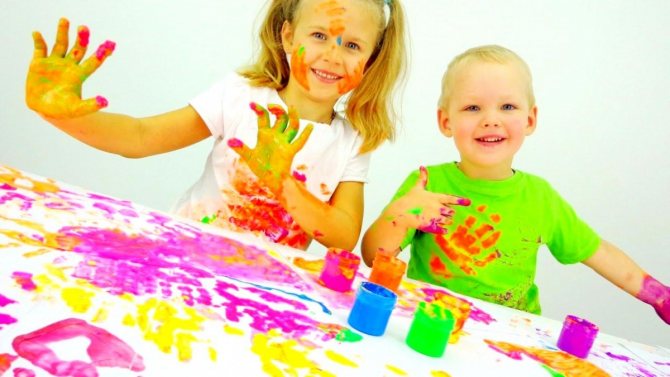
- Tassels. For preschool children, it is better to buy large paint brushes that leave wide and bright marks on the paper. Also, drawing tools can be construction rollers, sponges for washing dishes, brushes, rags, etc.
- Soft oil pastel. This type of wax crayons is good for drawing with kids because it leaves bright marks on the paper and, at the same time, does not stain everything around, so oil pastels can be kept in the open.
- Soft dry pastel has a consistency similar to chalk. If you draw with dry pastels on bright contrasting paper, you will get very interesting drawings. The disadvantage of this drawing tool is that dry pastels break and crumble easily, so they require careful handling.
- Wax crayons. Many experts advise starting to draw with wax crayons, however, compared to oil pastels, they are not as soft and bright.
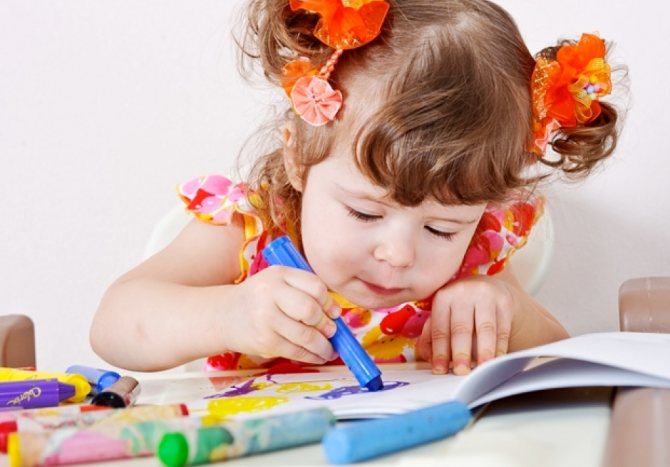
- Pencils. From the age of 1.5 years, you can begin to introduce your child to pencils. It is best to choose thick and soft pencils.
- Markers. Most experts note such disadvantages of felt-tip pens as the inability to mix colors and adjust the pressure. However, felt-tip pens have one big advantage - they leave very bright marks on paper, and this arouses genuine interest among children. It is important to note that there are water-based markers that can be easily washed off from almost any surface.
In order for a child to maximize his creative abilities, nothing should hold him back. This applies to both psychological and physical factors. The size of the paper on which the child draws should not be smaller than A4. It is best to draw on rolling paper or whatman paper. Many experts do not recommend using children's tables and easels for drawing, but are of the opinion that it is most convenient for a child to draw on the floor.
During developmental classes, children draw with crayons, pencils, paints, and also use non-traditional drawing tools (sponges, straws, stencils, etc.). Creative activities with preschoolers are aimed at developing fine motor skills, thinking, imagination, and aesthetic perception.
I.A. Galkina (Ph.D.)
Drawing is one of the most interesting types of creative activity for preschool children. “The origins of children’s abilities and talents are at their fingertips. From the fingers, figuratively speaking, come the finest threads - streams that feed the source of creative thought. In other words, the more skill in a child’s hand, the smarter the child,” writes V. A. Sukhomlinsky. By drawing, a child develops himself both physically and mentally, since the functioning of fine motor skills directly affects the functioning of the brain. Children who draw well reason more logically, notice more, and listen more attentively. Fine arts classes train the child’s hand and fingers, which creates favorable conditions for the development of writing skills. The creation of images and fantasies contributes to the development of logical and spatial thinking, the development of associative thinking, which is necessary when mastering mathematics. The famous teacher I. Disterweg believed: “The one who draws gets more in one hour than the one who just watches for nine hours.” According to scientists, children's drawing is involved in the development and coordination of interhemispheric relationships, since the process of drawing involves both concrete figurative thinking, associated mainly with the work of the right hemisphere of the brain, and abstract logical thinking, for which the left hemisphere is responsible.
Being associated with the most important mental functions - vision, motor coordination, speech and thinking, drawing not only contributes to the development of each of these functions, but also connects them with each other.
While drawing, the child develops fine motor skills, trains memory and attention, learns to think and analyze, fantasize, measure and compare. Children develop coherent speech through drawing activities. Drawing is involved in the construction of visual images, helps to master forms, and develops sensory-motor coordination. Children comprehend the properties of materials, learn the movements necessary to create certain shapes and lines. All this leads to a gradual understanding of the environment, the child’s aesthetic feelings and abilities develop.
For the mental development of children, the gradual expansion of the stock of knowledge based on ideas about the variety of forms of spatial arrangement of objects in the surrounding world, various sizes, and a variety of shades of colors is of great importance. The formation of ideas about objects requires the acquisition of knowledge about their properties and qualities, shape, color, size, position in space. Children define and name these properties, compare objects, find similarities and differences, that is, perform mental actions. Thus, visual activity promotes sensory education and the development of visual and figurative thinking.
The assimilation and naming of shapes, colors and their shades, spatial designations contributes to the enrichment of the vocabulary; statements in the process of observing objects, when examining objects, buildings, as well as when examining illustrations and reproductions of artists’ paintings have a positive effect on the expansion of vocabulary and the formation of coherent speech.
In the process of drawing, preschoolers master many practical skills that will later be needed to perform a wide variety of jobs and acquire manual skill, which allows them to feel more independent. If a child regularly draws, then he develops such traits as perseverance, attentiveness, patience, accuracy, and the ability to plan the work process, which are very important when starting school.
The importance of visual activity also lies in the fact that it is a means of aesthetic education. The direct aesthetic feeling that arises when perceiving a beautiful object includes various constituent elements: a sense of color, a sense of proportion, a sense of form, a sense of rhythm. For the aesthetic education of children and for the development of their visual abilities, familiarity with works of fine art is of great importance. Gradually, children develop artistic taste.
Drawing also gives you the opportunity to freely express your emotions, thoughts and sensations. By drawing, the child receives joy and pleasure, as well as satisfaction from his work and from life itself, so drawing is useful for children to relieve stress and reduce emotional and psychological stress.
Advice for parents on organizing children's visual arts activities
- To introduce a child to the world of artistic creativity, it is recommended to use pencils and paints. It is worth paying attention to the choice of pencils for children. They should be soft enough to leave marks even with little force. It is advisable to purchase paints in bright shades, and be sure to have brushes of different sizes. Since a child cannot control the pressure when drawing with felt-tip pens, it is therefore not recommended to use them. Here, the important role of the adult is to trace the process of children’s assimilation of various methods of working with brushes and paints: on a dry background, on a wet background, and by washing. Children are taught to mix paints with white (in gouache) and dilute with water (in watercolor) to obtain different shades of colors; use different methods of drawing and obtaining shades of color, use different techniques when creating an image (simple pencil and paints - gouache, watercolor: colored wax crayons and gouache or watercolor, etc.).
- For a 4-5 year old child, you don’t have to buy a sketchbook, but simply buy cheap printer paper. At this age, children draw a lot and quickly, and this option will be convenient for both them and their parents. For preschoolers who will be going to school next year, on the other hand, it is best to buy a real sketchbook. Let your child learn to draw on paper of this format, so he will feel more confident in drawing lessons at school.
- A lot depends on the initial lessons in drawing and coloring. If you do not pay attention to how a child holds a writing object, this may further affect their preparation for school. First of all, take a closer look at whether the child is holding the pencil (brush) correctly. His arm should not be too tense, and his hand should not be rigidly fixed. When drawing, it is important to be able to move freely and uninhibitedly. This will make the strokes lighter and smoother. Pay attention to the child's posture. It is necessary to sit upright, coloring with one hand, and holding a sheet of paper or notebook with a drawing with the other. The adult’s task is to teach the child to hold a brush and pencil with three fingers (between the thumb and middle finger, holding it on top with the index finger), while the hand lies on the table up to the elbow or can be raised, leaning on a drawing pencil (or brush, chalk, etc. .). You need to draw with a pencil with different pressure (lightly touching the paper to get light shades and thin, light lines and pressing harder to get bright color and strong energetic lines). This will allow you to achieve expressiveness of lines and images, since the line is one of the main components of the drawing. When painting with a brush, children learn to draw lines with the entire bristle and the end of it to obtain wide and thin lines.
- Show your child that you can color pictures using strokes of different lengths. Let there be very short strokes at the very edge, and long strokes closer to the center. You need to paint in one direction, without gaps, pressing evenly on the pencil. When drawing, pay attention to the appropriate use of color. You can use the following exercises: “Color it too”, “What is this color”.
- Make “albums” where you will place your child’s drawings. Hang one or two of your child's best works on the door or refrigerator and let him tell your guests about his drawings.
- For the comprehensive development of drawing skills in children, conduct various types of classes: subject drawing (doing work from life), drawing by choice, drawing by idea, plot drawing, decorative drawing.
- The most common drawings are drawings from life. Ask your child to draw himself, looking in the mirror, his favorite toy, mom, dad. You can use photographs. Before you start drawing, discuss with your child the features of the object being depicted. If unusual details appear in the drawing, be sure to ask where they came from. To develop children's creativity while drawing, you should not insist on the authenticity of the image.
- The child has his own vision, his own attitude towards what he draws.
- At the initial stage of teaching children to draw, it is advisable to include a large number of playful moments in classes and play with objects. Basic techniques of the preparatory period: demonstration, hand-in-hand technique. In the future, the following techniques are more often used: partial display, explanation. Use non-standard drawing methods, it is very exciting, interesting and useful (for example, finger drawing, palm painting, etc.).
Of course, parents can teach their children how to draw on their own, using their own experience and special teaching aids. But drawing classes for children, taught by a professional artist, an artist-teacher who knows all the intricacies of the process of learning to draw, are very useful. In our developmental classes in fine arts (FINE and ARTWORK) are taught by experienced and highly professional artists with special pedagogical training. On our website and in the building you can see wonderful drawings by our children.
Stages of development of children's drawings
| Age | Contents of drawings |
| Up to 1.5 years | Stroke stage. At this age, children enjoy the colorful marks they can leave on paper. Provide your child with as many creative materials as possible so he can express himself. |
| 1.5 – 3.5 years | Doodle stage. The drawings made by children at this age do not differ in appearance from the drawings of the previous stage, but the child already puts his own meaning into them, wanting to depict something specific. |
| 3.5 – 8 years | Schematic stage. At this age, children usually begin to draw familiar houses, flowers, and the sun. The child depicts only the important details of the object, without taking into account the proportions. |
| 8 – 10 years | Stage of plausible images. Children at this age try to depict the object as accurately as possible, details are drawn, proportions are taken into account. |
| After 10 years | Correct images. The drawings become three-dimensional and realistic. |
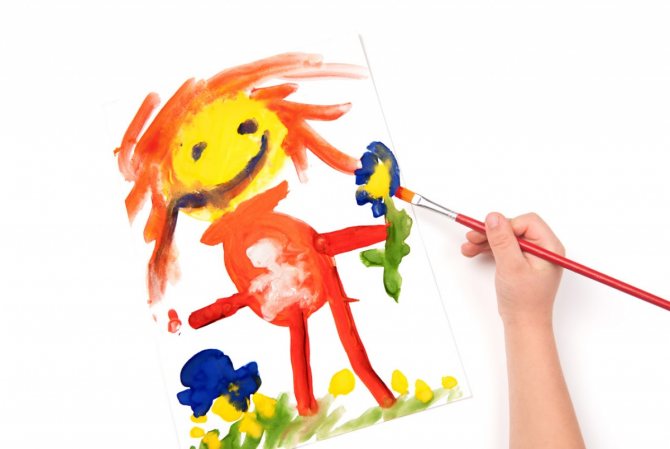
Experts separately highlight the features of children’s depiction of humans:
| Age | Features of the image of a person |
| 4 years | The body is usually round or oval, there is no neck. The proportions are not respected. |
| 5 years | Gender differences appear (girls and boys are depicted differently), details (ears, hair, clothes). |
| 6 years | Drawing small details, maintaining proportions. The neck is shown. |
| 7 years | The drawing becomes more realistic. The face can be drawn not only from the front, but also from the profile. |
| 8 years | The line of the neck, shoulders and arms is continuous. |
| 9 years | A person can be depicted in various poses, and movement is captured. |
| 10-11 years | The desire to create a three-dimensional image. |
Drawing with paints, methodological development for drawing (junior group) on the topic
Makarova Olga Alexandrovna
Educator at GBUZTO Specialized Children's Home
Painting with paints
Goals and objectives
- Learning to use paints correctly and carefully, dip the tip of a brush or finger in them, and use a brush correctly; hold a brush; draw lines, draw dots, etc. with light movements; Wash the brush and store it with the bristles facing up.
- Learning to navigate on a sheet of paper.
- Development of a sense of color.
- Development of emotions and fantasy.
- Development of fine motor skills.
- Speech development.
- Familiarization with the surrounding world.
- Formation of interest in drawing.
Materials and tools
Watercolor and gouache paints, special paints for finger painting; round and flat brushes of different sizes; various types of paper, colored matte cardboard; palette; wooden geometric figures (cube, cone, etc.). Optional equipment; oilcloths for tables, aprons or robes (according to the number of children), rags or napkins, sippy cups (with a suction cup on the bottom) for water, etc. If possible, use easels.
Drawing technique
Drawing on wet paper - applying paint to a sheet that has been previously moistened with water. This results in a plotless drawing in which you can observe blurry outlines, smooth transitions, and mixing of colors.
Finger painting is applying paint to paper using your fingertips. It is convenient to draw with the tip of the index finger of your dominant hand. When a finger touches the paper, fingerprints remain on it in the form of round colored spots, and when it is drawn across the paper, lines 3-6 cm long are obtained. Special paints, gouache or watercolor are used. The paints are diluted to the consistency of sour cream and poured into flat lids. When changing colors, wash your fingers in a jar of water and wipe with a napkin.
Palm painting involves applying a layer of paint to the inside of your palm and applying it to a piece of paper to make a print. The paint can be applied with a brush or by touching the paint in the saucer with your palm. When applying paint, use different colors with a brush. When placing your palm on the paper, you can squeeze or spread your fingers.
Painting with a brush - applying paints to paper using a brush. In this case, you should first wet the brush, then take the paint on it and easily, without pressure, apply it to the paper. This technique uses brushes - round and flat, paints - watercolor and gouache (watercolor in tubes is pre-diluted), paper - watercolor and other thick paper. There are three ways to paint with a brush;
- dabbing - applying colored spots to the base by applying a brush with paint to the paper. After contact with the paper, the brush should be applied immediately; without carrying out smears, tear it away from it,
- applying strokes - drawing with a brush by drawing lines of different lengths in different directions (top to bottom, left to right, etc.):
- painting with a brush over a pencil sketch - applying paints over a simple pencil sketch consisting of simple lines and shapes (straight, vertical and horizontal lines, circles, semicircles, ovals).
Drawing with a stamp - applying paint to the surface of a special shape (stamp), applying the stamp with a paint layer to the paper and pressing it to obtain a color print. One or more colors can be applied to a stamp. Using this method, you can create identical prints in any quantity, and create different images from prints of the same and different shapes. As stamps, you can use wooden geometric figures from a toy construction set or cut out templates of the desired shape from vegetables (carrots, potatoes).
Preparing to Draw
Before starting the lesson, you should prepare your workplace. It is necessary to lay oilcloth on the tables, and children should wear special oilcloth aprons or robes with elasticated sleeves. Only the essentials should be on the table. First (when painting with fingers or palms) - a sheet of paper and one paint for each child, or paper, paint, a brush and a jar of water when painting with a brush. When children learn to paint carefully (wipe their hands with a napkin, do not spill water, do not stain the table or clothes with paint), you can offer several paints.
What to draw with?
Use special paints for hand painting, gouache, semi-dry watercolor or in tubes (in this case, the paint is diluted with water before work); non-toxic good quality.
Remember that watercolor is transparent paint and the paper can be seen through it. If you need a lighter color, watercolor is diluted with water; if you need to correct bad places, then the paint layer is washed off with water. As the watercolor dries, the painting becomes a little lighter.
Gouache is an opaque paint. If a lighter shade of color is required, white is added. If you need to correct bad places, you should paint on top of the paint layer. When the gouache dries, the drawing becomes much lighter.
At first, it is better to draw with your fingers and palms, using special paints. If such paints are not available, you can use gouache or watercolor. This kind of drawing will help to introduce children to such materials for fine arts as paints, to study their properties and artistic possibilities. But you should be careful and make sure that children draw only on paper. If one of the kids doesn’t want to dip their finger in the paint during the first lesson, don’t force them. Give children the opportunity to watch your actions and the drawings of other kids. Explain that drawing with fingers and palms is very interesting, and that dirty hands can be washed later.
When painting with a brush, round and flat brushes of different sizes are used, but when working with children, it is preferable to use large brushes that leave a large, bright mark on the paper.
When drawing with a stamp, wooden geometric figures (cubes, cylinders or cones, etc.), vegetables from which forms for printing are cut out, and various wooden toy figures with flat surfaces are used.
What to draw on?
Paints should be painted on watercolors or any other thick paper in A4 and/or A3 format. Even if the drawing is small, you should offer a sheet of sufficiently large size. This is necessary so that the child learns not to go beyond the boundaries of the sheet of paper while drawing. In this case, the sheets, as a rule, should be arranged horizontally, as in an album. Collective works are performed on larger paper (wat)
Subjects of works
In classes with young children, simple stories that are close to the children’s experience should be used. In order to reproduce an image of a familiar object, the child must perceive it purposefully. An adult can help to see a familiar object or phenomenon again, highlight significant features: color, shape, location in space, etc. During painting classes, scenes that children are already familiar with from working with pencils and felt-tip pens, modeling, and appliqué are often repeated. For example, the same grass or Christmas tree can be depicted using lines drawn with a pencil, paint using a finger or a brush.
Organization of classes
Classes can be conducted individually or in a small group. The teacher should sit at the same table with the children in order to be able to help each child. Initially, the lesson lasts 10-15 minutes, gradually increasing the duration of the lesson. To strengthen the kids’ skills, the same plot can be repeated several times. Classes are held in the form of a game. All drawings contain a plot. An adult comments on the drawing process.
Operating procedure
The lessons are given in blocks, each of which describes game tasks aimed at practicing a certain way of working with paints - diluting and mixing paints, drawing on wet paper, drawing with fingers and palms, brushes, stamping. Learning to paint using the described techniques can be carried out in parallel or in stages. It should be taken into account that if work on teaching children several drawing techniques is carried out in parallel, then new skills may be mixed and not consolidated in the child’s mind. We advise you to simultaneously use various methods at the final stage of generalization classes.
Rules for using paints and brushes
First of all, it is necessary to teach children the rules of handling paints and brushes. Show how to carefully take paint onto a finger or brush, not to get dirty, explain that paints should be stored carefully, and paint jars should be closed after finishing work. Show the kids how to use a brush, how to hold it, wet it in water and remove excess water on the edge of the jar, how to take paint on the tip of the brush, paint with light movements, do not press the brush, do not rub the brush on the paper, wash the brush before using another paint. Explain that the brush cannot be left in the water for a long time, otherwise it will become distorted, that after painting it must be washed and placed in a glass with the bristles facing up. After completing the work, you need to wait for the paint on the drawing to dry.
Help
At the initial stages of learning to draw, it is possible for a child to work together with an adult who takes the child’s hand in his own and helps him dip his finger in paint, draw lines with a brush, make prints using a stamp, etc. When the skills are consolidated, drawing is done by demonstration (sequential demonstration of each stage) and drawing according to the finished sample. In addition, the adult helps children position the image on a piece of paper by sketching, or pointing with their finger, where the image should be placed on the paper.
Storage of works
From the first steps of children's creative activity, attention and respect for their work must be shown. On each drawing you should write the date of its creation and the name of the author. Storing each child's work in a separate folder allows you to explore the dynamics of the development of each child's drawing skills. You can file drawings and you will get an album, and if you write text for them (1-3 short sentences) you will get a book.
It is necessary to periodically organize exhibitions of children's works, preferably after each lesson. Be attentive to the kids, do not forget to praise them for their successes and achievements. To do this, look at their drawings, comment on them emotionally, show them to other children and adults, and give them a positive assessment.
Precautionary measures
To prevent children from staining furniture, clothes, floors, walls and themselves with paint, we advise you to give them only in class, teach them to use them under the supervision of an adult, and then put them out of the reach of children.
Free drawing for kids
With the help of drawing, children develop their creative and intellectual abilities. How to make development happen as quickly as possible? There are two opposing opinions on this matter. The first, and most common, point of view is that drawing in any form contributes to the creative development of children. Therefore, many parents buy their children all kinds of manuals with drawing tasks, coloring books, albums, as well as special drawing tools (for example, unusual brushes, stamps, etc.). This kind of “drawing” teaches the child not to put in too much effort to achieve a result and develops fine motor skills rather than creativity. The second point of view is the opposite of the first. Its supporters believe that there is no need to provide the child with ready-made templates for drawing and specially teach the child to draw different objects. To unleash a child’s creative potential and develop his intellect, you don’t need anything extra. Creative thinking develops when the child himself comes up with what to draw. Paper, brushes and paints are the best tool for developing creativity. This approach promotes “free” drawing.
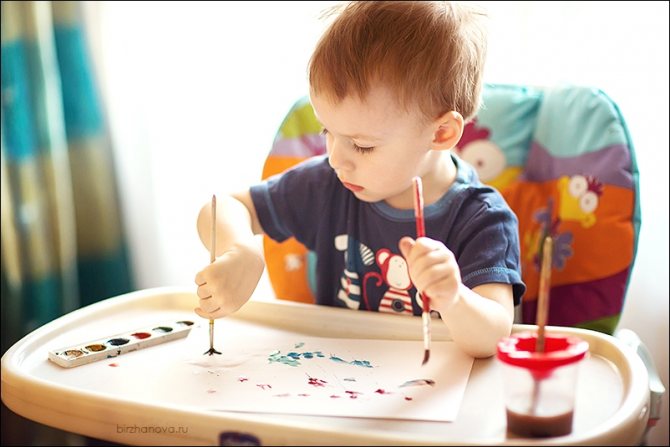
Don’t rush to expect artistic masterpieces from your child in early childhood. Before the child begins to produce realistic images, the baby's drawings will go through the stages of strokes, scribbles and schematic images.
In preschool age, it is very important to provide the child with creative freedom. Let your child figure out how best to draw the sun or a house. The theory of free drawing says that it is necessary to protect the child as much as possible from patterns in drawing. Since such standards surround us everywhere in everyday life, we need to try to ensure that the patterns that a child encounters (in books, TV, in classes) are of high quality.
To help the art teacher prepare for the lesson
Game screensavers in the lesson
All children love to play. Teachers should keep this in mind when developing the structure of their lessons. The introduction of even a small game into the lesson allows not only to diversify it and interest students in the topic being studied, but also provides an opportunity to once again summarize and consolidate new material. Some games can gradually become the main ones (children like them), and therefore they should be used in all subsequent lessons related to the same topic.
What games can be used in art lessons? Firstly, associative, developing children’s imagination and imaginative thinking. These games will be based on musical and literary works used during lessons, to which students will need to choose paintings by an artist that convey the same mood or main idea.
For example, a teacher can play an excerpt from any musical composition, and after listening to it, invite the children to find in the reproductions presented to their eyes the one with which this music is best combined, and then briefly formulate the reason for this conclusion. If the opinions of several children surveyed differ, the task can be left until the end of the lesson. At the same time, it is necessary to interest children in the question and make them think. This can be done with the help of an incentive prize, which will go to the one who correctly answers and explains the task at the end of the lesson.
The same game can be used when comparing paintings and literary works, characteristics of the images of the main characters, descriptions of nature. What is important here is not just the selection of the right work, but also the identification of its connections and those literary expressions with the help of which the author managed to create an impression similar to that depicted. After each such playful minute, the teacher, together with the children, can write down on the board the main verbal phrases that emphasize the mood of the work. Thanks to this, children will remember them, and in future work they will use them, making their own descriptions of the paintings. You should try to remember these highlighted words in the next lesson or throughout the lesson. This will help develop students' memory, especially if they are interested in completing this task.
Another variation could be a guessing game. The teacher’s task here is to come up with questions about the works of art being viewed that will require the children to solve them. You can, for example, inquire about the name of a painting unfamiliar to children. Naturally, there will be a lot of versions about this, and it is possible that children will even find its real version. During this guessing, you should ask leading questions: “What is the main goal of the work?”, “What is the compositional center of the picture?”
Generalizing tasks can also be taken in the form of riddles, such as, for example, identifying the best artists in a particular genre or reminding of the most frequently repeated images in works of art and the names of these paintings. These can be images of the same epic and fairy-tale characters in different or similar situations, the image of a woman with a child, etc. Another task is to identify works made in a similar color scheme, or to reproduce in memory portraits of famous artists and the authors who wrote them (who was written and by what artist?).
The game “Lost Piece” is also very interesting. Its essence is that the teacher shows students a piece (corner, episode) of any picture known from previous topics, and the students try to remember its name, content, and author. Naturally, children will be able to determine which piece of the picture is shown to them if, when studying this topic, they were very attentive and carefully examined and remembered the works shown to them.
This game usually captivates students so much that they ask the teacher to arrange it every day - and thus give the teacher the opportunity not only to test the strength of their knowledge and attentiveness, but also to increase their own attentiveness to the paintings shown. Gradually, students will be able to more and more quickly determine the title and author of the work, and therefore they will have to complicate the task: show less remarkable elements of the picture or show a completely unknown picture, asking them to determine its author, relying on knowledge of the artists’ writing style and their preferred themes. In addition, you can give verbal descriptions of the picture, from which students will also have to identify the hidden work.
As a rule, children love to imitate someone. This feature can also be used in a game, for example, by inviting schoolchildren to reproduce the scene depicted in the picture, come up with a continuation of it, or describe the feelings of the depicted person at the moment after his “awakening”. What does he see, hear, what does he think about? A lot of opportunities in this regard are provided by paintings of everyday content or with images of people: “Again deuce”, “Fight of Ilya Muromets with the Snake”, etc.
During the lesson it is worth holding competition games. This allows children to be captivated and once again provides an opportunity to consolidate the material they have covered. In the form of a competition, you can play the game “I am a tour guide.” A number of reproductions, united by one theme, are displayed in front of the class, and then all students take turns playing the role of a tour guide and offer the audience their story about the exhibited works. At the end of the game, a winner is chosen by vote. And when children already have the basic skills of composing a story based on a picture, reproductions of artists can be replaced with the work of the students themselves. This will provide an opportunity to hear about the impressions of the whole class about each of the presented works, i.e., find out their opinion on this matter.
The game “I’m making it up” can be a similar competition to this. It is carried out as follows: the teacher asks the students any topic, gives them time to think (you can play music with the necessary mood at this moment), and then the students talk about the fictitious picture that they painted in their imagination. At the end of the game, the stories can also be evaluated. Naturally, only the child who knows how to convey his fantasies in a literary and coherent way will win. This game is good to use when it is necessary to develop children's imagination and the ability to compose a consistent story.
Children are also very attracted to games that are similar to those they come up with themselves. These include, for example, the game “Fair”. It can be done as follows: arrange a large exhibition in the classroom. Moreover, each stand should be dedicated to the work of one of the schoolchildren. Then, together with the class, write an announcement that throughout the day there will be a fair in the drawing room, where you can “buy” any drawing, and just for a few kind words about the work itself.
When students from other classes come into the classroom during breaks, the teacher must explain that the authors will “sell” their works to those who can correctly describe the work they like, determine its main idea and come up with a story based on it. In addition, the author is given the right to ask the “buyer” additional questions at his own discretion. With the help of this game, an art teacher will be able not only to attract students from other classes to his lessons, but will also demonstrate the need for children to apply the acquired knowledge in practice.
If all kinds of games and competitions are held at school constantly, then you can prepare special medals for the best students and winners: “Master of still life”, “Specialist in the field of pictorial writing”, etc. At the end of the year, a school-wide result can be summed up, where according to the collected medals and the best artist of the school will be determined and then awarded.
conclusions
The main task of a parent when teaching a child to draw is to instill an interest in creativity. To make your child love to draw, do not bother him with advice, appreciate his efforts. Give your child the opportunity to draw freely, do not hamper his imagination with ready-made templates, this is the only way he can fully develop his creative potential. Introduce your child to aesthetics, choose books with good quality illustrations, well-drawn cartoons, and, if possible, visit museums and exhibitions.
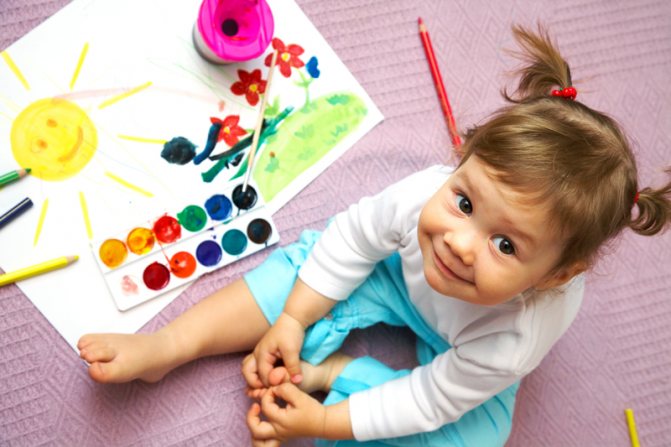
Drawing and developing (about the benefits of drawing for preschool children)
Bibliographic description:
Rodina, N. N. Drawing and developing (about the benefits of drawing for preschool children) / N. N. Rodina. — Text: direct // Questions of preschool pedagogy. — 2022. — No. 2 (12). — P. 29-33. — URL: https://moluch.ru/th/1/archive/87/3183/ (access date: 01/19/2022).
Creativity is a constant companion of child development. The best way to develop creativity is activity.
L. S. Vygotsky
Childhood is the most important period of human life: bright, original, unique. Children's world is special. The uniqueness of the preschool period lies in the fact that it is here that the foundations for the comprehensive development of the child are laid, his creative potential is revealed, and the basic ideas of children are formed.
The most interesting and attractive activity for preschoolers during this period is drawing, because it gives children the opportunity to convey their impressions of the surrounding reality in their own drawings. This process of self-expression creates a feeling of joy and pleasure in preschoolers. What they don’t do: they paint your favorite wallpaper with pencils, and the curtains with paints, and draw on each other with felt-tip pens. All this brings great happiness to children. However, we adults are sometimes too harsh towards such manifestations of the creative potential of our kids, and we regretfully say goodbye to spoiled things. But drawing has a huge impact on the formation of a child’s personality. For this reason, try to pull yourself together and do not scold your child for the fact that his creativity goes beyond what is permitted. Help direct the development of his talent in the right direction.
The baby only benefits from drawing. The connection between drawing and a child’s thinking is especially important. At the same time, visual, motor, and muscular-tactile analyzers are included in the work. In addition, drawing develops memory, attention, fine motor skills, teaches the child to think and analyze, measure and compare, compose and imagine. For the mental development of children, the gradual expansion of the stock of ideas about the world around them is of great importance. It affects the formation of an active vocabulary and coherent speech in a child. Agree, the variety of shapes of objects in the surrounding world, different sizes, variety of shades of colors, spatial designations only contribute to the enrichment of the baby’s speech development. By taking up drawing, a child learns to observe and discern the beauty of the world around him in colors. For example, in nature there are more than a hundred shades of green; the night can be not only dark and frightening, but also moonlit and magical. Golden autumn can be delightfully beautiful, while late autumn can be cold and dull. You can say about winter - cold and angry or warm, snowy, fluffy and much more.
In the process of visual activity, the child’s mental and physical activity is combined. To create a drawing, you need to make an effort, work hard, mastering certain skills. At first, children develop an interest in the movement of a pencil or brush, in the marks left on paper; only gradually does the motivation for creativity appear - the desire to get a result, to create a certain image.
The formation of a creative personality is one of the most important tasks of pedagogical theory and practice at the present stage. Solving it should begin already in preschool age, since it is at this age that children have great potential for imagination and creativity based on self-expression, self-development, cooperation, and co-creation.
Many scientists, teachers, and psychologists are trying to re-evaluate traditional approaches to developing creativity in preschool children. Such searches lead to a revision of the familiar and well-known, help not to dwell on what has already been achieved, “shake up” and enrich. As a result of searches and discoveries, children's activities become more and more free, joyful and successful.
“The main way for the development of children’s personality is the organization of meaningful activities, the presence of cooperation between an adult and children” (L. A. Wenger).
A truly amazing phenomenon of childhood is play activity, through which preschoolers learn about the world around them, learn and develop. Particular attention should be paid to direct educational activities, which, taking into account the age characteristics of preschoolers, are carried out in a fairy-tale-game form. I build the methodology of working with children in such a way that, along with acquiring new ideas, skills and abilities through art and children's visual activities, the child develops such qualities as independence, initiative, creative activity, allowing self-realization in various types and forms artistically - creative activity, complexities and stiffness disappeared.
The highest form of independence for children is creativity. It is the visual arts classes that are mainly subordinated to the implementation of creative tasks focused on children’s independent work and the search for non-standard solutions.
What do creative abilities include? They include such qualities of the mind as observation, the ability to compare and analyze, combine, find connections and dependencies, patterns, etc.
The use of TRIZ methods - the theory of solving inventive problems - helps me with this. It was created by the scientist and inventor G.S. Altshuller and adapted for preschool age, which allows you to raise and teach a child under the motto “Creativity in everything!” The use of non-traditional forms of work puts the preschooler in the position of a thinking person. The purpose of using this technology in kindergarten is to develop, on the one hand, such qualities of thinking as flexibility, mobility, systematicity, dialecticism, and on the other hand, search activity, the desire for novelty, the development of speech and creative imagination. The main goal of using TRIZ technology in preschool age is to lay the foundations for the development of a creative personality.
To make classes with children interesting and not boring, I use different TRIZ methods. Here are some of them: brainstorming (idea generation), where criticism is unacceptable; empathy - reincarnation (I invite children to “transform” or merge into something - a stone, a snowflake, the wind, etc.), which requires enormous imagination; the fecal object method is a search for new ideas by attaching properties or characteristics of random objects, etc. to the original object.
My work with children involves the discovery and realization of children's inexhaustible creative potential through familiarization and use of non-traditional artistic drawing techniques and increasing children's interest in artistic creativity. A variety of drawing methods and unusual methods of visual activity give children original ideas, develop fantasy and imagination. There are no strict assignments and strict control here, but there is creative freedom and genuine joy. The result is usually very effective and almost does not depend on skill and ability.
Experimentation in drawing is the basis of children's creative fantasies. And you can draw with anything: a piece of chalk, charcoal, pencil, felt-tip pen, fountain pen, gouache, watercolor, sanguine, pastel, wax crayons, ink, toothbrush, foam rubber, fingers, palm, stick, using a computer and even a ray of light! Any discovery of something new and unusual will bring children relaxation, joy and give impetus to creativity. Children's drawing is intuitive. Imagination and fantasy are the most important aspect of a child’s life. They do not know what is right and what is wrong. They draw as they think.
Non-traditional drawing techniques carried out by me bring variety to the visual arts and provide the child with more chances for self-expression: “Drawing with fingers and palm”, “Spraying”, “Blotography”, “Printing”, “Pamponing”, “Monotype”, “Hard brush drawing” , “Colored threads”, “Drawing with wax crayons”, “Scratching”, “Drawing on fabric”, “Familiar form - new image” and much more. In order to develop imagination and creativity, I invite children to depict: their mood, their dream, music, smell, themselves, family, friends, something mysterious and magical (a non-existent animal, a fantastic plant, etc.).
Artistic creativity in preschool age is the creation by a child of a subjectively new product that is meaningful to him. A preschooler is a born explorer. And this is confirmed by their curiosity, constant desire to experiment, desire to independently find solutions in creative searches.
In order to summarize the work with children in the artistic and aesthetic direction and to identify the level of individual development of the students, I compiled a script for the “Young Artists” quiz. The children of the two teams gladly answered the questions and riddles related to artistic creativity offered to them. For example: 1. “With what colors can you paint the whole world?” 2. “How many colors does the rainbow have? (name them)"; 3. “What two groups are all colors divided into?” (warm and cold); 4. Riddles by genre of painting: landscape, portrait, still life. 5. “I mix the paints on it and get a new color. It's not always big, but it's comfortable, no doubt about it. She is friendly with paints. Well, tell me, who is she?” (Palette). 6. “How to get color for the Christmas tree, cucumber and grass on the porch?” (children mix paints to get the desired color) and other questions.
The creative abilities of students develop not only in classes, but also in free activity. The basis of a child’s independent creativity is experimentation and search activity. “Children’s creative activities can be neither obligatory nor compulsory and can only arise from children’s interests” L. S. Vygotsky.
Psychologists say that 6–7 years of age is the “golden age” of children's drawing. At this time, children have already reached a certain maturity and harmoniously interact in creativity with practical life experience of communicating with different people and working with different materials, experience of emotional and intellectual processing. Having gained strength, children's drawing is actively implemented at the age of 8–10, improving, becoming more complex and expanding its thematic boundaries.
Children's drawing is the optimal form of realizing a child's personality, which will fade into the background over time. For this reason, it is very important not to miss this time and help the child realize the importance of the presence of drawing in his life. Indeed, simultaneously with the fading of the desire to fantasize, the possibilities of creative thinking in children decrease, and their interest in both art and creativity decreases. Children's creative imagination needs continuous development; to achieve this goal, special formation and organization of visual activity is necessary. Speaking about the problem of children's creative abilities, it is necessary to emphasize that their effective development is possible only with the joint efforts of both preschool teachers and the family.
I offer some useful tips for parents that will help develop their children’s fantasy, imagination and creativity, and make their childhood memories bright and happy: let in sunbeams; watch the seeds germinate; slide down a high icy mountain together; bring a branch from the frost and put it in water; to look at the stars; prepare burnt sugar in a spoon; shade coins and leaves hidden under paper; make a volcanic eruption from citric acid and soda, etc.
Most children draw with paints, and, of course, this is correct. But isn’t it interesting to know what happens if you draw with coffee grounds, berries, plasticine, even poplar or reed fluff, a toothbrush, a piece of brick, a paint brush, a bird’s feather, etc. Children also love to print. And it's so easy. It is enough to fold a paper napkin in several layers and moisten it with paint. Then press various objects onto it and make imprints (spools, buttons, keys, pieces of carrots, potato seals, etc.)
What else can you think of? The variety of materials available for work poses new challenges and forces you to come up with something; if you draw on a round (square or triangular) object or sheet of paper, then its shape forces you to think differently about your future drawing each time.
You can make a large panel from the outlined hands of all family members or footprints, which are very convenient to draw on the back of the wallpaper left after renovation.
Have you tried painting with water? Children's imagination is limitless. With a spray bottle made from plastic bottles, children can draw circles, ovals, simple and more complex images: birds, animals, people, cars, etc. But the water on the asphalt quickly dries out and the drawing disappears. Add paint to the water. In one bottle - red, in another - yellow, and so on (you can use old dried gouache). The drawings will become colorful and will last longer.
All this once again confirms that the beginning of a child’s independent creativity lies in spontaneous experimentation and search activity.
Research behavior is one of the most important conditions for the development of the intellectual and creative potential of children.
“The origins of children’s abilities and talents are at their fingertips. From the fingers, figuratively speaking, come the finest threads - streams that feed the source of creative thought. In other words, the more skill in a child’s hand, the smarter the child,” argued V. A. Sukhomlinsky.
The more diverse and original the search activity, the more opportunities there are to ultimately obtain a new result, and originality is an indicator of creativity.
Let's summarize and draw a conclusion: what are the benefits of drawing for children:
– In the process of visual activity, a child experiments with various materials for drawing, mixes paints on the palette and gets new colors and shades, plays, and he gets a drawing - the final, visible result of his activity;
– By doing painting, children become familiar with art and culture;
– Learn to express their feelings and emotions in drawings;
– They learn to manage their time, they can occupy themselves with drawing;
– A creative approach develops, that is, an image of the world around him (for example, summer, autumn) or one object in different versions;
– Improves imagination and spatial intelligence;
– Painting classes are a very important preparation for school; drawing contributes to the development of fine motor skills;
– Develops discipline and perseverance;
– Thinking develops, that is, the child thinks about the idea of his drawing;
– The child learns to conduct dialogic speech, explains what he drew, why, etc.;
– The child learns to compare and generalize;
– By doing painting, he becomes the “Creator of the World.” He creates his own world and this is very important.
Adults need to support the child’s interest in drawing, for this you need:
– Evaluate each drawing positively;
– Show interest or admiration for the drawing (this is important for a little artist);
– Praise the child’s creative and interesting discoveries, not the child himself;
– Avoid criticism and comments;
– Do not force, but interest him in the drawing process;
– Compare drawings and find positive dynamics in them (each time the drawings are getting better and better);
– Develop observation skills in children, that is, make observations in nature together with the children (shades of greenery, snow, sky, seasons, etc.).
– Provide the child with the opportunity to practice drawing and modeling at home. To do this, each family should have various visual materials: gouache, pencils, pastels, felt-tip pens, plasticine, etc.
– Joint creativity of children and parents.
Each child is a separate world with its own rules of behavior, its own feelings. And the richer and more varied the child’s life experiences, the brighter and more extraordinary his imagination, the more likely it is that the intuitive craving for art will become more meaningful over time.
Children are naturally endowed with bright abilities; you just need to try, as early as possible, to create the most favorable conditions for their development, to give the child the joy of creativity and awareness of the author's voice. “Children should live in a world of beauty, games, fairy tales, music, drawing, fantasy, creativity.” V. A. Sukhomlinsky. Remember that the development of creativity ensures your child's success in life.
Literature:
- Altshuller, G. S. Creativity as an exact science. The theory of solving inventive problems. - 2004, 203 p.
- Asmolkova, V., Chernova T. Drawing with sand. For senior preschool age // Preschool education. - 2013 - No. 5 - p. 79.
- Beloskova, S. Collective compositions using different techniques // Preschool education. - 2013 - No. 6 - p.65.
- Vaganova, N. A. Studying the characteristics of the manifestation of creative potential in older preschoolers. // Gifted child. –2008. - No. 5. - P. 36.
- Gin, S.I. TRIZ classes in kindergarten: a manual for teachers of preschool educational institutions. — 2010.
- Davydova, G. N. Non-traditional drawing techniques. - M., 2007.
- Zakharyuta, N. Modern approach to the development of a creative personality. // Preschool education. - 2006. - No. 3. - P. 21.
- Ivanova, I. et al. “Music and colors.” Senior preschool age.// Preschool education. - 2013 - No. 4. - p.55.
- Kazakova, R. G. Drawing classes with preschoolers. Non-traditional techniques. - M., 2008.
- Komarova, T. S. Children's artistic creativity: A methodological manual for educators and teachers. - M., Mozaika-Sintez, 2005.
- Korzun, A.V. Fun didactics: elements of TRIZ and RTV in working with preschoolers. - Minsk, 2000.
- Krylov, E. School of creative personality. // Preschool education. - 1997. - No. 5. P. 44; No. 10. - P. 28.
- Kudryavtsev, V. The phenomenon of children's creativity. // Preschool education. - 2006. - No. 5. - P. 71.
- Lykova, I. A. Didactic games and activities. Integration of artistic and cognitive activities. - M., 2009.
- Lykova, I. A. Experimentation in children's artistic creativity. – M., 2003.
- Novikovskaya, O. A. Mind at your fingertips. - M., AST; St. Petersburg Owl, 2006.
- Ozerova, O. E. Development of creative thinking and imagination in children. Games and exercises. - Rostov na/D., 2005.
- Prokhorova, L. N. Experience of methodological work in preschool educational institutions on the development of creativity of preschool children. - M., 2007.
Key terms
(automatically generated)
: child, visual activity, preschool age, the world around us, drawing, drawing, creativity, children's drawing, paint, artistic creativity.


